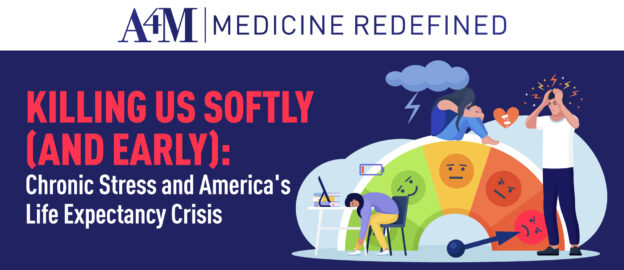Life expectancy is a key indicator of a nation’s health and well-being. However, despite having similar resources to other developed countries, life expectancy has seen a concerning decline in America. Most recent data from the Centers for Disease Control and Prevention (CDC) reveals U.S. life expectancy has declined to 76.4 years, the shortest in nearly two decades.
When compared with other high-income countries, the United States falls short. Premature deaths have reached historically high rates, and the U.S. has among the highest maternal and infant mortality rates among its counterparts.
Physicians and public health experts have identified chronic stress as not just a significant contributing factor to this life expectancy crisis but also a societal epidemic.
The Chronic Stress Crisis
Chronic stress, often stemming from systemic injustice, adverse experiences, and economic instability, takes a toll on overall well-being. Research shows it can accelerate biological aging and the development of chronic illnesses, ultimately shortening lifespans.
But what’s driving America’s chronic stress epidemic?
The causes are multifaceted, but common stressors include financial strain, unaffordable housing, inadequate healthcare, poor education access, and lack of social support systems. Unfortunately, these impacts tend to hit marginalized communities hardest.
Chronic stress has far-reaching implications for health and longevity, as explained by the influential “weathering hypothesis.”
The Weathering Hypothesis
Once derided but now mainstream, the weathering hypothesis suggests chronic stress causes heightened susceptibility to illness and premature aging. When we experience repeated stress, our fight-or-flight response activates, flooding the body with cortisol. In normal circumstances, hormone levels return to baseline when threats pass. However, our bodies rarely recover from stress-induced states in a fast-paced, hyperconnected, and unjust environment. The physiological impacts accumulate and ultimately severely impact health.
Chronic stress progression damages the cardiovascular, immune, endocrine, and metabolic systems. This leaves the population more susceptible to infectious diseases, earlier onset of chronic conditions, and premature mortality.
The Link Between Chronic Stress and Illness
Prolonged stress can trigger an array of detrimental health impacts over time. Blood pressure remains elevated, inflammation becomes chronic, and plaque begins to form in the arteries, increasing the risk of cardiovascular disease. High-effort coping, the constant struggle to overcome barriers, takes a toll on the body, leading to poor health outcomes.
Two essential mechanisms involved in increased vulnerability to adverse health effects are inflammation and immune dysfunction. Chronic stress promotes systemic inflammation by continually activating the body’s stress response. This floods the body with pro-inflammatory cytokines, resulting in ongoing low-grade inflammation. Such prolonged inflammation can progressively damage tissues and organs, laying the groundwork for age-related conditions like heart disease, diabetes, and neurodegeneration.
Chronic stress not only affects physical health but also takes a toll on mental well-being. Dysregulated cortisol levels can trigger depression and anxiety, interfere with sleep patterns, and contribute to poor mental health. Children and adolescents experiencing chronic stress may be more prone to academic, behavioral, and health problems, including obesity and depression.
Coping with unremitting stressors requires high physiological effort and promotes cellular aging.
How Stress Shortens Telomeres and Accelerates Aging
At the cellular level, chronic stress has been linked to accelerated biological aging through its effects on telomeres. Telomeres — protective caps on chromosome ends — shorten naturally over time. However, studies show individuals with high cortisol tend to experience premature telomere shortening.
This stress-induced shortening causes a mismatch between someone’s chronological and biological age. Shorter telomeres are associated with impaired cellular function and increased risks for age-related diseases.
Chronic Stress, Disease, and Life Expectancy
Rising rates of chronic stress, correlated with a rise in mental health disorders and a steep decline in population health, cannot be ignored. Now at the crux of a silent epidemic, persistently high levels of stress have far-reaching, long-lasting, detrimental implications for overall health and life expectancy.
Extensive research demonstrates a clear link between prolonged stress and the premature onset and quickened progression of chronic disease. The mechanisms behind this correlation are multifaceted – from weathering effects and shortened telomeres to systemic disparities and adverse experiences. Together, these strain numerous body systems, hasten cellular decline, and promote chronic inflammation.
These effects interact to undermine health on multiple fronts, leaving the body vulnerable to a range of diseases earlier in life. Consequently, chronic stress has been linked to plummeting life expectancy trends, with studies revealing it can shorten lives by years. For instance, a recent study from the Finnish Institute for Health and Welfare found that being under heavy stress reduces lifespan by an average of 2.8 years.
Addressing Chronic Stress, Promoting Health and Longevity
With chronic diseases rising and life expectancy falling, chronic stress and its widespread impact have become a grave public health issue.
Tackling this crisis will require addressing the root causes of stress and making evidence-based wellness approaches more accessible to the population.
Prioritizing mental healthcare, teaching stress management techniques for resilience, and promoting healthy lifestyle interventions will be critical components of systemic initiatives. Meanwhile, increasing access to comprehensive medical services, preventative care, and health awareness programs is necessary to build a foundation for a healthier society.
A multi-pronged strategy focused on prevention and resilience-building must become a priority to combat disease burden and enable longer healthier lifespans. This multidimensional approach should promote equity, reduce stressors, and foster a healthier and more supportive environment for all individuals.
Healthcare professionals must recognize the importance of addressing stress as a longevity risk factor and can play a major role in providing support systems to mitigate its expansive effects.

